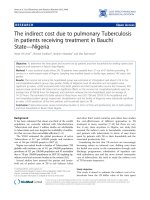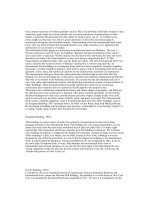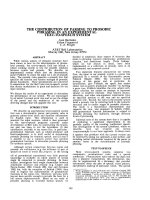Risk management and Financial institutions 4th
Bạn đang xem bản rút gọn của tài liệu. Xem và tải ngay bản đầy đủ của tài liệu tại đây (11.57 MB, 743 trang )
Risk Management
and Financial
Institutions
Founded in 1807, John Wiley & Sons is the oldest independent publishing company in the United States. With offices in North America, Europe, Australia and
Asia, Wiley is globally committed to developing and marketing print and electronic
products and services for our customers’ professional and personal knowledge and
understanding.
The Wiley Finance series contains books written specifically for finance and investment professionals as well as sophisticated individual investors and their financial
advisors. Book topics range from portfolio management to e-commerce, risk management, financial engineering, valuation and financial instrument analysis, as well
as much more.
For a list of available titles, visit our Web site at www.WileyFinance.com.
Risk Management
and Financial
Institutions
Fourth Edition
JOHN C. HULL
Cover image: ©iStock.com/Pinkypills
Cover design: Wiley
Copyright © 2015 by John C. Hull. All rights reserved.
Published by John Wiley & Sons, Inc., Hoboken, New Jersey.
The Third Edition was published by John Wiley & Sons, Inc. in 2012. The first and second editions of
this book was published by Prentice Hall in 2006 and 2009.
Published simultaneously in Canada.
No part of this publication may be reproduced, stored in a retrieval system, or transmitted in any form or
by any means, electronic, mechanical, photocopying, recording, scanning, or otherwise, except as
permitted under Section 107 or 108 of the 1976 United States Copyright Act, without either the prior
written permission of the Publisher, or authorization through payment of the appropriate per-copy fee to
the Copyright Clearance Center, Inc., 222 Rosewood Drive, Danvers, MA 01923, (978) 750-8400,
fax (978) 646-8600, or on the Web at www.copyright.com. Requests to the Publisher for permission
should be addressed to the Permissions Department, John Wiley & Sons, Inc., 111 River Street, Hoboken,
NJ 07030, (201) 748-6011, fax (201) 748-6008, or online at />Limit of Liability/Disclaimer of Warranty: While the publisher and author have used their best efforts in
preparing this book, they make no representations or warranties with respect to the accuracy or
completeness of the contents of this book and specifically disclaim any implied warranties of
merchantability or fitness for a particular purpose. No warranty may be created or extended by sales
representatives or written sales materials. The advice and strategies contained herein may not be suitable
for your situation. You should consult with a professional where appropriate. Neither the publisher nor
author shall be liable for any loss of profit or any other commercial damages, including but not limited to
special, incidental, consequential, or other damages.
For general information on our other products and services or for technical support, please contact our
Customer Care Department within the United States at (800) 762-2974, outside the United States at
(317) 572-3993 or fax (317) 572-4002.
Wiley publishes in a variety of print and electronic formats and by print-on-demand. Some material
included with standard print versions of this book may not be included in e-books or in print-on-demand.
If this book refers to media such as a CD or DVD that is not included in the version you purchased, you
may download this material at . For more information about Wiley
products, visit www.wiley.com.
Library of Congress Cataloging-in-Publication Data:
Hull, John, 1946–
Risk management and financial institutions / John C. Hull. — Fourth Edition.
pages cm. — (Wiley finance series)
Includes index.
ISBN 978-1-118-95594-9 (paper); ISBN 978-1-118-95596-3 (ePDF);
ISBN 978-1-118-95595-6 (ePUB)
1. Risk management. 2. Financial institutions—Management. I. Title.
HD61.H83 2015
332.1068'1—dc23
2014037477
Printed in the United States of America
10
9
8
7
6
5
4
3
2
1
To Michelle, Peter, and David
Contents in Brief
Business Snapshots
Preface
Chapter 1: Introduction
xxi
xxiii
1
PART ONE : FINANCIAL INSTITUTIONS AND THEIR TRADING
Chapter 2: Banks
Chapter 3: Insurance Companies and Pension Plans
Chapter 4: Mutual Funds and Hedge Funds
Chapter 5: Trading in Financial Markets
Chapter 6: The Credit Crisis of 2007
Chapter 7: Valuation and Scenario Analysis: The Risk-Neutral and Real Worlds
25
45
71
93
121
137
PART TWO : MARKET RISK
Chapter 8: How Traders Manage Their Risks
Chapter 9: Interest Rate Risk
Chapter 10: Volatility
Chapter 11: Correlations and Copulas
Chapter 12: Value at Risk and Expected Shortfall
Chapter 13: Historical Simulation and Extreme Value Theory
Chapter 14: Model-Building Approach
153
175
201
231
255
277
299
PART THREE : REGULATION
Chapter 15: Basel I, Basel II, and Solvency II
Chapter 16: Basel II.5, Basel III, and Other Post-Crisis Changes
Chapter 17: Fundamental Review of the Trading Book
325
353
373
PART FOUR : CREDIT RISK
Chapter 18: Managing Credit Risk: Margin, OTC Markets, and CCPs
Chapter 19: Estimating Default Probabilities
Chapter 20: CVA and DVA
Chapter 21: Credit Value at Risk
383
401
429
447
PART FIVE : OTHER TOPICS
Chapter 22: Scenario Analysis and Stress Testing
Chapter 23: Operational Risk
Chapter 24: Liquidity Risk
Chapter 25: Model Risk
Chapter 26: Economic Capital and RAROC
Chapter 27: Enterprise Risk Management
Chapter 28: Risk Management Mistakes to Avoid
463
481
501
527
547
565
579
PART SIX : APPENDICES
Appendices
Answers to Questions and Problems
Glossary
DerivaGem Software
Tables for N(x)
Index
591
629
669
689
695
699
vii
Contents
Business Snapshots
Preface
xxiii
CHAPTER 1
Introduction
1.1
1.2
1.3
1.4
1.5
1.6
1.7
xxi
Risk vs. Return for Investors
The Efficient Frontier
The Capital Asset Pricing Model
Arbitrage Pricing Theory
Risk vs. Return for Companies
Risk Management by Financial Institutions
Credit Ratings
Summary
Further Reading
Practice Questions and Problems (Answers at End of Book)
Further Questions
1
2
5
8
13
13
17
18
19
19
19
20
PART ONE
FINANCIAL INSTITUTIONS AND THEIR TRADING
CHAPTER 2
Banks
2.1
2.2
2.3
2.4
2.5
2.6
2.7
2.8
Commercial Banking
The Capital Requirements of a Small Commercial Bank
Deposit Insurance
Investment Banking
Securities Trading
Potential Conflicts of Interest in Banking
Today’s Large Banks
The Risks Facing Banks
Summary
Further Reading
Practice Questions and Problems (Answers at End of Book)
Further Questions
25
26
28
30
31
36
37
38
41
42
43
43
44
ix
x
CONTENTS
CHAPTER 3
Insurance Companies and Pension Plans
3.1
3.2
3.3
3.4
3.5
3.6
3.7
3.8
3.9
3.10
3.11
3.12
Life Insurance
Annuity Contracts
Mortality Tables
Longevity and Mortality Risk
Property-Casualty Insurance
Health Insurance
Moral Hazard and Adverse Selection
Reinsurance
Capital Requirements
The Risks Facing Insurance Companies
Regulation
Pension Plans
Summary
Further Reading
Practice Questions and Problems (Answers at End of Book)
Further Questions
CHAPTER 4
Mutual Funds and Hedge Funds
4.1
4.2
4.3
4.4
Mutual Funds
Hedge Funds
Hedge Fund Strategies
Hedge Fund Performance
Summary
Further Reading
Practice Questions and Problems (Answers at End of Book)
Further Questions
CHAPTER 5
Trading in Financial Markets
5.1
5.2
5.3
5.4
5.5
5.6
5.7
5.8
5.9
The Markets
Clearing Houses
OTC Market Changes
Long and Short Positions in Assets
Derivatives Markets
Plain Vanilla Derivatives
Non-Traditional Derivatives
Exotic Options and Structured Products
Risk Management Challenges
Summary
Further Reading
Practice Questions and Problems (Answers at End of Book)
Further Questions
45
45
49
50
53
54
56
58
59
60
61
61
63
66
67
68
69
71
71
79
84
88
89
90
90
91
93
93
94
95
96
97
98
108
112
114
116
116
117
119
xi
Contents
CHAPTER 6
The Credit Crisis of 2007
6.1
6.2
6.3
6.4
6.5
The U.S. Housing Market
Securitization
The Crisis
What Went Wrong?
Lessons from the Crisis
Summary
Further Reading
Practice Questions and Problems (Answers at End of Book)
Further Questions
CHAPTER 7
Valuation and Scenario Analysis: The Risk-Neutral and Real Worlds
7.1
7.2
7.3
7.4
7.5
7.6
Volatility and Asset Prices
Risk-Neutral Valuation
Scenario Analysis
When Both Worlds Have to be Used
The Calculations in Practice
Estimating Real-World Processes
Summary
Further Reading
Practice Questions and Problems (Answers at End of Book)
Further Questions
121
121
124
130
131
133
134
135
135
136
137
138
139
144
144
145
146
147
148
148
148
PART TWO
MARKET RISK
CHAPTER 8
How Traders Manage Their Risks
8.1
Delta
8.2
Gamma
8.3
Vega
8.4
Theta
8.5
Rho
8.6
Calculating Greek Letters
8.7
Taylor Series Expansions
8.8
The Realities of Hedging
8.9
Hedging Exotic Options
8.10 Scenario Analysis
Summary
Further Reading
Practice Questions and Problems (Answers at End of Book)
Further Questions
153
153
160
162
164
165
166
167
168
169
170
172
172
172
173
xii
CONTENTS
CHAPTER 9
Interest Rate Risk
9.1
9.2
9.3
9.4
9.5
9.6
9.7
9.8
9.9
CHAPTER 10
Volatility
10.1
10.2
10.3
10.4
10.5
10.6
10.7
10.8
10.9
10.10
175
178
182
185
187
189
191
193
196
197
197
198
199
Definition of Volatility
Implied Volatilities
Are Daily Percentage Changes in Financial Variables Normal?
The Power Law
Monitoring Daily Volatility
The Exponentially Weighted Moving Average Model
The GARCH(1,1) Model
Choosing Between the Models
Maximum Likelihood Methods
Using GARCH(1,1) to Forecast Future Volatility
Summary
Further Reading
Practice Questions and Problems (Answers at End of Book)
Further Questions
201
204
205
207
209
212
214
216
216
222
225
226
227
228
CHAPTER 11
Correlations and Copulas
11.1
11.2
11.3
11.4
11.5
175
The Management of Net Interest Income
Types of Rates
Duration
Convexity
Generalization
Nonparallel Yield Curve Shifts
Interest Rate Deltas in Practice
Principal Components Analysis
Gamma and Vega
Summary
Further Reading
Practice Questions and Problems (Answers at End of Book)
Further Questions
Definition of Correlation
Monitoring Correlation
Multivariate Normal Distributions
Copulas
Application to Loan Portfolios: Vasicek’s Model
Summary
Further Reading
Practice Questions and Problems (Answers at End of Book)
Further Questions
201
231
231
233
236
238
244
250
250
250
252
xiii
Contents
CHAPTER 12
Value at Risk and Expected Shortfall
12.1
12.2
12.3
12.4
12.5
12.6
12.7
12.8
12.9
12.10
Definition of VaR
Examples of the Calculation of VaR
A Drawback of VaR
Expected Shortfall
Coherent Risk Measures
Choice of Parameters for VaR and ES
Marginal, Incremental, and Component Measures
Euler’s Theorem
Aggregating VaRs and ESs
Back-Testing
Summary
Further Reading
Practice Questions and Problems (Answers at End of Book)
Further Questions
CHAPTER 13
Historical Simulation and Extreme Value Theory
13.1
13.2
13.3
13.4
13.5
13.6
The Methodology
Accuracy of VaR
Extensions
Computational Issues
Extreme Value Theory
Applications of EVT
Summary
Further Reading
Practice Questions and Problems (Answers at End of Book)
Further Questions
CHAPTER 14
Model-Building Approach
14.1
14.2
14.3
14.4
14.5
14.6
14.7
14.8
14.9
14.10
The Basic Methodology
Generalization
Correlation and Covariance Matrices
Handling Interest Rates
Applications of the Linear Model
Linear Model and Options
Quadratic Model
Monte Carlo Simulation
Non-Normal Assumptions
Model-Building vs. Historical Simulation
Summary
Further Reading
Practice Questions and Problems (Answers at End of Book)
Further Questions
255
255
257
258
259
260
263
268
269
270
270
273
274
274
275
277
277
282
284
289
289
292
295
295
296
297
299
299
302
303
307
310
311
314
316
317
318
319
319
319
321
xiv
CONTENTS
PART THREE
REGULATION
CHAPTER 15
Basel I, Basel II, and Solvency II
15.1
The Reasons for Regulating Banks
15.2
Bank Regulation Pre-1988
15.3
The 1988 BIS Accord
15.4
The G-30 Policy Recommendations
15.5
Netting
15.6
1996 Amendment
15.7
Basel II
15.8
Credit Risk Capital Under Basel II
15.9
Operational Risk Capital Under Basel II
15.10 Pillar 2: Supervisory Review
15.11 Pillar 3: Market Discipline
15.12 Solvency II
Summary
Further Reading
Practice Questions and Problems (Answers at End of Book)
Further Questions
CHAPTER 16
Basel II.5, Basel III, and Other Post-Crisis Changes
16.1
16.2
16.3
16.4
16.5
Basel II.5
Basel III
Contingent Convertible Bonds
Dodd–Frank Act
Legislation in other Countries
Summary
Further Reading
Practice Questions and Problems (Answers at End of Book)
Further Questions
CHAPTER 17
Fundamental Review of the Trading Book
17.1
17.2
17.3
New Market Risk Measures
Trading Book vs. Banking Book
Credit Trades
Summary
Further Reading
Practice Questions and Problems (Answers at End of Book)
Further Questions
325
325
326
327
330
331
333
336
337
346
346
347
347
349
349
350
351
353
353
357
365
366
368
370
371
371
372
373
373
377
378
379
379
379
380
xv
Contents
PART FOUR
CREDIT RISK
CHAPTER 18
Managing Credit Risk: Margin, OTC Markets, and CCPs
18.1
18.2
18.3
18.4
Margin and Exchanges
OTC Markets
Consequences of New OTC Regulations
The Risk of a CCP Failure
Summary
Further Reading
Practice Questions and Problems (Answers at End of Book)
Further Questions
CHAPTER 19
Estimating Default Probabilities
19.1
19.2
19.3
19.4
19.5
19.6
19.7
19.8
Credit Ratings
Historical Default Probabilities
Recovery Rates
Credit Default Swaps
Credit Spreads
Estimating Default Probabilities from Credit Spreads
Comparison of Default Probability Estimates
Using Equity Prices to Estimate Default Probabilities
Summary
Further Reading
Practice Questions and Problems (Answers at End of Book)
Further Questions
CHAPTER 20
CVA and DVA
20.1
20.2
20.3
20.4
20.5
20.6
20.7
Credit Exposure on Derivatives
CVA
The Impact of a New Transaction
CVA Risk
Wrong-Way Risk
DVA
Some Simple Examples
Summary
Further Reading
Practice Questions and Problems (Answers at End of Book)
Further Questions
383
383
388
392
396
396
397
397
398
399
399
401
403
404
409
412
414
419
422
422
423
424
427
427
429
432
434
435
436
437
441
442
442
443
xvi
CONTENTS
CHAPTER 21
Credit Value at Risk
21.1
21.2
21.3
21.4
21.5
Ratings Transition Matrices
Vasicek’s Model
Credit Risk Plus
Creditmetrics
Credit-Sensitive Instruments in the Trading Book
Summary
Further Reading
Practice Questions and Problems (Answers at End of Book)
Further Questions
445
446
448
449
451
454
457
458
458
459
PART FIVE
OTHER TOPICS
CHAPTER 22
Scenario Analysis and Stress Testing
22.1
22.2
22.3
Generating the Scenarios
Regulation
What to Do with the Results
Summary
Further Reading
Practice Questions and Problems (Answers at End of Book)
Further Questions
CHAPTER 23
Operational Risk
23.1
Defining Operational Risk
23.2
Determination of Regulatory Capital
23.3
Categorization of Operational Risks
23.4
Loss Severity and Loss Frequency
23.5
Implementation of AMA
23.6
Proactive Approaches
23.7
Allocation of Operational Risk Capital
23.8
Use of Power Law
23.9
Insurance
23.10 Sarbanes-Oxley
Summary
Further Reading
Practice Questions and Problems (Answers at End of Book)
Further Questions
CHAPTER 24
Liquidity Risk
24.1
24.2
Liquidity Trading Risk
Liquidity Funding Risk
463
463
469
473
476
476
477
478
479
481
481
483
484
485
489
492
492
493
494
495
496
496
497
499
499
507
xvii
Contents
24.3
Liquidity Black Holes
Summary
Further Reading
Practice Questions and Problems (Answers at End of Book)
Further Questions
CHAPTER 25
Model Risk
25.1
25.2
25.3
25.4
25.5
25.6
25.7
25.8
Marking to Market
Models for Linear Products
Physics vs. Finance
How Models are Used for Pricing Standard Products
Hedging
Models for Nonstandard Products
Dangers in Model Building
Detecting Model Problems
Summary
Further Reading
Practice Questions and Problems (Answers at End of Book)
Further Questions
CHAPTER 26
Economic Capital and RAROC
26.1
26.2
26.3
26.4
26.5
26.6
26.7
26.8
Definition of Economic Capital
Components of Economic Capital
Shapes of the Loss Distributions
Relative Importance of Risks
Aggregating Economic Capital
Allocation of Economic Capital
Deutsche Bank’s Economic Capital
RAROC
Summary
Further Reading
Practice Questions and Problems (Answers at End of Book)
Further Questions
CHAPTER 27
Enterprise Risk Management
27.1
27.2
27.3
27.4
Risk Appetite
Risk Culture
Identifying Major Risks
Strategic Risk Management
Summary
Further Reading
Practice Questions and Problems (Answers at End of Book)
Further Questions
515
522
522
523
524
525
525
527
529
530
536
537
540
541
542
542
543
543
545
545
547
549
551
552
555
557
557
559
559
559
560
563
564
568
572
574
575
576
576
576
xviii
CONTENTS
CHAPTER 28
Risk Management Mistakes to Avoid
28.1
28.2
28.3
28.4
28.5
Risk Limits
Managing the Trading Room
Liquidity Risk
Lessons for Nonfinancial Corporations
A Final Point
Further Reading
577
577
580
582
585
586
587
PART SIX
APPENDICES
Appendix A
Compounding Frequencies for Interest Rates
591
Appendix B
Zero Rates, Forward Rates, and Zero-Coupon Yield Curves
595
Appendix C
Valuing Forward and Futures Contracts
599
Appendix D
Valuing Swaps
601
Appendix E
Valuing European Options
603
Appendix F
Valuing American Options
605
Appendix G
Taylor Series Expansions
609
Appendix H
Eigenvectors and Eigenvalues
613
Appendix I
Principal Components Analysis
617
Appendix J
Manipulation of Credit Transition Matrices
619
Appendix K
Valuation of Credit Default Swaps
621
Contents
xix
Appendix L
Synthetic CDOs and Their Valuation
625
Answers to Questions and Problems
629
Glossary
669
DerivaGem Software
689
Table for N(x) when x ≤ 0
Table for N(x) when x ≥ 0
Index
695
697
699
Business Snapshots
1.1
2.1
2.2
2.3
3.1
3.2
4.1
5.1
5.2
5.3
5.4
5.5
6.1
6.2
8.1
8.2
8.3
10.1
10.2
12.1
15.1
16.1
18.1
19.1
19.2
19.3
22.1
22.2
23.1
23.2
24.1
24.2
24.3
24.4
25.1
25.2
25.3
The Hidden Costs of Bankruptcy
Google’s IPO
PeopleSoft’s Poison Pill
How to Keep Loans Performing
Equitable Life
A Perfect Storm
Mutual Fund Returns Can Be Misleading
The Unanticipated Delivery of a Futures Contract
A Software Error?
Microsoft’s Hedging
Procter and Gamble’s Bizarre Deal
SocGen’s Big Loss in 2008
All BBBs Are Not the Same
A Trading Opportunity?
Hedging by Gold Mining Companies
Dynamic Hedging in Practice
Is Delta Hedging Easier or More Difficult for Exotics?
What Causes Volatility?
Making Money from Foreign Currency Options
Historical Perspectives on VaR
Systemic Risk
Credit Suisse’s CoCo Bond Issues
Rehypothecation
The CDS Market
Is the CDS Market a Fair Game?
Contagion
Long-Term Capital Management’s Big Loss
Traffic Light Options
The Hammersmith and Fulham Story
Rogue Trader Insurance
Northern Rock
Ashanti Goldfields
Metallgesellschaft
The Crash of 1987
Kidder Peabody’s Embarrassing Mistake
Exploiting the Weaknesses of a Competitor’s Model
Crashophobia
15
35
36
40
52
65
78
102
103
113
114
115
130
134
156
169
170
203
206
256
326
366
395
405
407
418
467
473
490
494
508
511
512
518
528
529
533
xxi
xxii
25.4
26.1
27.1
27.2
28.1
BUSINESS SNAPSHOTS
The London Whale
The EGT Fund
The Santander Rail Deal
Abacus
Big Losses
539
551
570
571
578
Preface
R
isk management practices and the regulation of financial institutions have continued to evolve in the past three years. Risk Management and Financial Institutions
has been expanded and updated to reflect this. Like my other popular text Options,
Futures, and Other Derivatives, the book is designed to be useful to practicing managers as well as college students. Those studying for GARP and PRMIA qualifications
will find the book particularly helpful.
The book is appropriate for university courses in either risk management or
financial institutions. It is not necessary for students to take a course on options and
futures markets prior to taking a course based on this book. But if they have taken
such a course, some of the material in the first nine chapters does not need to be
covered.
The level of mathematical sophistication and the way material is presented have
been managed carefully so that the book is accessible to as wide an audience as possible. For example, when covering copulas in Chapter 11, I present the intuition followed by a detailed numerical example; when covering maximum likelihood methods
in Chapter 10 and extreme value theory in Chapter 13, I provide numerical examples
and enough details for readers to develop their own Excel spreadsheets. I have also
provided my own Excel spreadsheets for many applications on my website:
www-2.rotman.utoronto.ca/∼hull
This is a book about risk management, so there is very little material on the
valuation of derivatives. (This is the main focus of my other two books, Options,
Futures, and Other Derivatives and Fundamentals of Futures and Options Markets.)
The appendices at the end of the book include material that summarizes some of
the valuation key results that are important in risk management, and the DerivaGem
software can be downloaded from my website.
NEW MATERIAL
The fourth edition has been fully updated and contains much new material. In
particular:
1. There is a new chapter comparing scenario analysis to valuation (Chapter 7).
The chapter introduces the reader to the statistical processes often assumed for
xxiii









